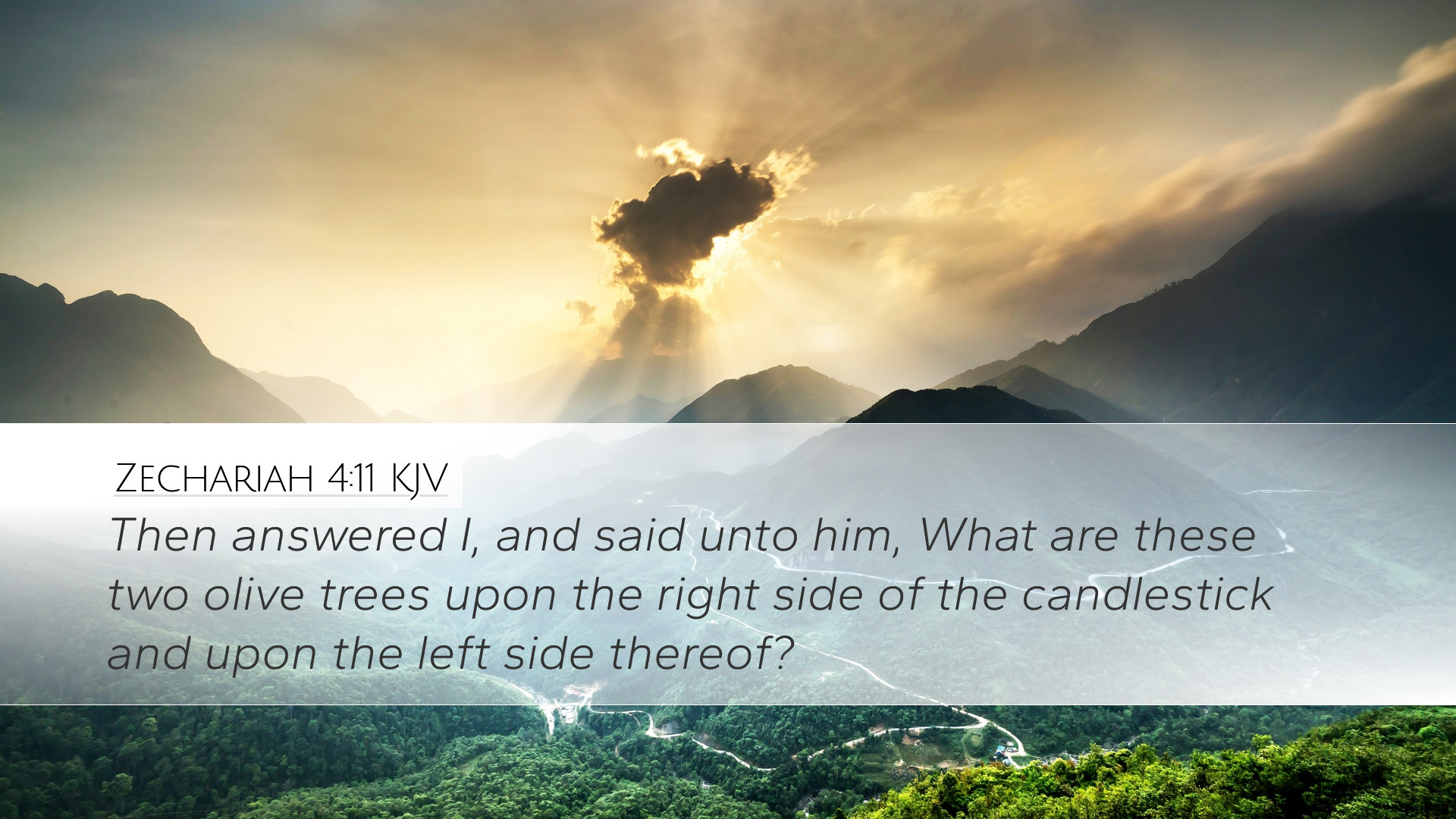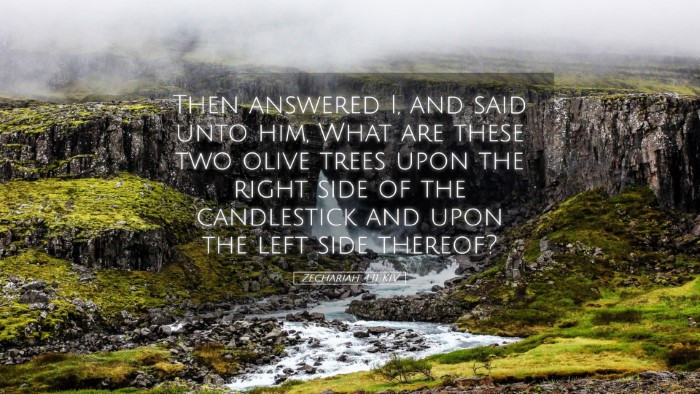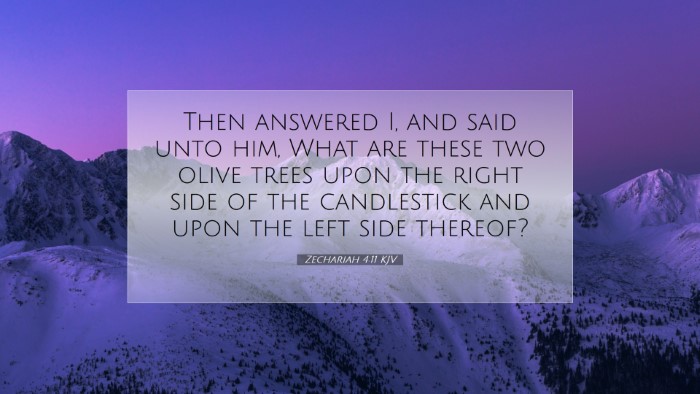Old Testament
Genesis Exodus Leviticus Numbers Deuteronomy Joshua Judges Ruth 1 Samuel 2 Samuel 1 Kings 2 Kings 1 Chronicles 2 Chronicles Ezra Nehemiah Esther Job Psalms Proverbs Ecclesiastes Song of Solomon Isaiah Jeremiah Lamentations Ezekiel Daniel Hosea Joel Amos Obadiah Jonah Micah Nahum Habakkuk Zephaniah Haggai Zechariah MalachiZechariah 4:11
Zechariah 4:11 KJV
Then answered I, and said unto him, What are these two olive trees upon the right side of the candlestick and upon the left side thereof?
Zechariah 4:11 Bible Commentary
Commentary on Zechariah 4:11
Verse Context: Zechariah 4:11 states, "Then answered I, and said unto him, What are these two olive trees upon the right side of the candlestick and upon the left side thereof?" This verse springs from a broader prophetic vision experienced by the prophet Zechariah, designed to encourage the leadership of Israel in a time of uncertainty and reconstruction after their return from exile.
General Interpretation
This passage reflects the prophetic imagery that permeates the book of Zechariah. The two olive trees and the golden lampstand symbolize the source of divine oil, representing anointing and the Spirit of God that empowers His people, particularly in leadership roles. The imagery is rich with implications for both the immediate context of Zerubbabel and Joshua as well as for broader eschatological themes.
Insights from Matthew Henry
Matthew Henry highlights that Zechariah's inquiry about the two olive trees represents a search for understanding concerning the divine support behind Israel's restoration and the temple's reconstruction. He emphasizes the symbolic function of the olive trees, which denote the two anointed ones or leaders—often interpreted as Zerubbabel (the civil leader) and Joshua (the high priest).
- Divine Empowerment: Henry notes that just as the olive trees supply oil to the lampstand, so do God's chosen leaders receive strength and clarity for their roles from the Holy Spirit.
- Symbol of Hope: He interprets the olive trees as a sign of God's continued favor despite Israel's historical failures.
- Reconstruction Ministry: The context of rebuilding underscores the importance of divine aid in leadership roles during difficult missions.
Insights from Albert Barnes
Albert Barnes expands upon the imagery by elucidating the significance of olive trees in biblical culture. He notes their association with peace, anointing, and the status of Israel as a beacon of light amidst nations. Barnes offers a detailed exploration into the oil that these trees produce and its centrality to the functioning of the lampstand, which symbolizes God's presence among His people.
- Symbolism of Oil: Oil not only fuels the lampstand but also signifies the presence of the Holy Spirit, vital for the illumination and guidance of God's people.
- Dual Leadership: Barnes interprets the presence of two trees as indicative of kingly and priestly roles working in harmony to fulfill God's plan.
- Prophetic Assurance: The assurance that God will supply what is needed for spiritual illumination and guidance is a key takeaway, prompting believers to trust in divine provision.
Insights from Adam Clarke
Adam Clarke offers a thorough exploration of the olive trees' significance within the context of Jewish religious practices. He draws parallels between the olive and God's covenant with Israel, expounding on how the preservation of the olive trees symbolizes the enduring promise God made to His people.
- Historical Significance: Clarke discusses the historical context of the olive tree as a staple in Israel, enriching the understanding of God's provision and blessings.
- Leadership and Service: He posits that the two olive trees could also represent two witnesses or the prophetic voice in Israel, emphasizing the call to serve God through spiritual leadership.
- Encouragement in Despair: Clarke reflects on the message of hope embedded in this imagery, assuring the people that God remains active and present in their reconstruction efforts.
Theological Implications
The theological implications of Zechariah 4:11 speak powerfully to contemporary issues in church leadership. The imagery of two nourished leaders suggests a divine sequence in which God equips His servants to achieve remarkably against overwhelming odds. This principle translates into the church's responsibility to rely not on human strength but on the empowerment of the Holy Spirit.
- Empowerment: The need for Spirit-filled, spirit-led leadership is crucial both in Zechariah’s time and in the current church context.
- Unity of Leadership: The co-functioning of civil and spiritual leadership illustrates the importance of partnership in achieving God’s mission on Earth.
- Hope and Assurance: The continuous flow of oil speaks to the sufficiency of God's grace and the assurance that He provides for every need of His church.
Conclusion
Zechariah 4:11 serves as a profound reminder of the divine workings that undergird the fabric of Israel’s restoration, and it provides timeless truths for today’s church. The significance of the olive trees as a source of oil for the lampstand invites modern believers to draw from the Spirit’s empowering presence. As pastors, students, theologians, and scholars study this passage, they uncover layers of meaning that encourage faithfulness in leadership and reliance on God’s spirit and provision for every task at hand.


